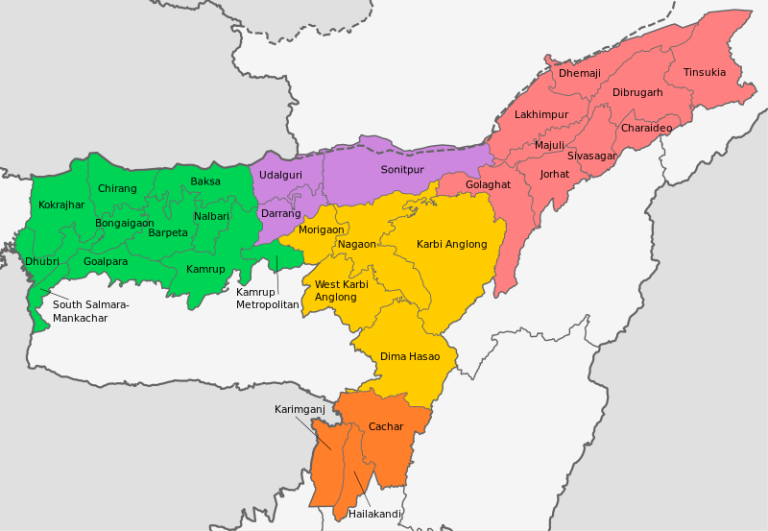How Can Rural Non-Farm Employment Be Promoted in Assam to Reduce Dependence on Agriculture? Assam , one of the most picturesque states of India, is primarily an agrarian economy. While agriculture remains a vital livelihood source for nearly 53% of the state's population, heavy reliance on it has contributed to economic vulnerabilities. Factors like unpredictable floods, fluctuating crop prices, and limited arable land hinder the sustainable growth of farming in rural Assam. Therefore, promoting **rural non-farm employment** is crucial to reduce over-dependence on agriculture and enhance economic stability. The challenge lies in creating diverse employment opportunities that tap into local skills and resources, while also offering solutions to modern challenges. This blog will explore practical ways to promote rural non-farm employment in Assam, with real-life examples, statistics, and engagement strategies. 1. The Importance of Non-Farm Employment Rural non-f...
District-Wise Sectoral Opportunities and Raw Materials in Assam for Developing Rural Non-Farm Employment
District-Wise Sectoral Opportunities and Raw Materials in Assam

Assam is divided into 35 administrative districts, which are primarily delineated based on natural features such as rivers, hills, and forests. Many of the newer districts were previously sub-divisions of older districts. On August 15, 2015, three new districts—Charaideo, South Salmara-Mankachar, and West Karbi Anglong—were created, expanding the previous count of 27 districts. Later, on June 27, 2016, Majuli was declared a district. Karbi Anglong is the largest district, covering approximately 10,434 square kilometers, followed by Sonitpur with 5,324 square kilometers. Majuli, carved out from northern Jorhat, is India's first river island district. Assam's districts are grouped into five regional divisions.
This document outlines the various sectoral opportunities for developing rural non-farm employment in Assam, categorized by districts. Additionally, it highlights the common raw materials found in most districts, which can be leveraged for local entrepreneurship and small-scale industries.
Common Raw Materials Found in Most Districts of Assam
- Bamboo
- Jute
- Tea Leaves
- Silk (Muga, Eri, and Mulberry)
- Medicinal Herbs
- Fish (from natural water bodies)
- Areca Nut (Betel Nut)
- Rice Husk
- Clay and Sand (for pottery and brick-making)
- Spices (Turmeric, Ginger, Chilies)
District-Wise Sectoral Opportunities
1. Kamrup District
- Handicrafts & Bamboo Products: Abundant bamboo resources can be used for making furniture, decorative items, and utilities.
- Tea Processing: Tea leaves can be processed locally for value addition.
- Silk Production: High potential for Muga and Eri silk weaving and production.
2. Barpeta District
- Jute Products: Jute available in the district can be used to manufacture bags, ropes, and eco-friendly items.
- Pottery: Availability of clay makes pottery a viable industry.
- Spice Processing: Turmeric and ginger can be processed for domestic and export markets.
3. Dibrugarh District
- Tea-Based Products: With large tea estates, there is scope for tea packaging, branding, and tea tourism.
- Handloom & Textile: Silk weaving, especially Muga and Eri, can be expanded for local and export markets.
- Medicinal Herbs Processing: Rich in medicinal herbs that can be processed for the pharmaceutical industry.
4. Cachar District
- Fish Processing: Local fisheries can develop small-scale fish processing units.
- Tea Production: The district is known for its tea, creating opportunities for local processing and value addition.
- Handicrafts: Bamboo and cane-based handicrafts can thrive here.
5. Nagaon District
- Agricultural Equipment Manufacturing: Rice husk and bamboo can be used for creating small-scale agricultural tools.
- Spice Processing: The district grows a significant amount of turmeric and ginger, which can be processed locally.
- Dairy & Poultry Farming: The district has potential for small-scale dairy and poultry ventures.
6. Tinsukia District
- Rubber Processing: Rubber plantations provide raw material for small-scale rubber goods manufacturing.
- Fish Farming: Water bodies support the development of aquaculture.
- Areca Nut Processing: The district is rich in areca nut, which can be processed for various products.
7. Sivasagar District
- Silk Weaving: The district is known for its silk, providing ample opportunities in handloom and textile industries.
- Oil and Gas Industry Support Services: Opportunities exist for ancillary industries that support oil and gas exploration.
- Herbal Products Manufacturing: Medicinal herbs can be processed for cosmetics and pharmaceuticals.
8. Golaghat District
- Eco-Tourism & Handicrafts: Proximity to Kaziranga National Park offers eco-tourism opportunities, while bamboo and cane products can be sold to tourists.
- Tea & Spice Processing: The district’s tea and spice production can be enhanced with value-added processing units.
- Pottery & Ceramics: Abundant clay resources allow for the development of pottery and ceramics industries.
9. Karbi Anglong District
- Bamboo Products: Extensive bamboo forests make bamboo-based furniture and crafts viable industries.
- Horticulture & Agro-Processing: Fruits and vegetables can be processed locally into jams, pickles, and packaged foods.
- Rubber Processing: Rubber plantations can support small-scale rubber goods manufacturing.
10. Nalbari District
- Dairy & Poultry Farming: Potential for developing small-scale dairy and poultry units for rural employment.
- Handloom & Weaving: Silk production and weaving can be scaled up in the district.
- Pottery: Availability of clay for pottery and brick-making industries.
Conclusion
The districts of Assam offer a wide range of opportunities for developing rural non-farm employment. Common raw materials like bamboo, jute, silk, and tea, available in most districts, provide a strong foundation for small-scale industries. By focusing on local resources and sectoral opportunities, rural Assam can see significant growth in non-farm employment.
How can skill development initiatives boost economic growth in Assam's rural economy?
Explore More:
Join the Conversation!
Leave a comment below, share this article, and explore more content on mindful self-reflection and personal growth.
Share this Article:
enhance using AI analysis.
Explore More:
Join the Conversation!
Leave a comment below, share this article, and explore more content on mindful self-reflection and personal growth.




Comments
Post a Comment